Japan[Kanagawa]Beyond ordinary itinerariesvol.11 Part1 Odawara Area in Kanagawa Prefecture
Listen to the Lingering Sounds of HistoryTourist Attractions Within 15 Minutes on Foot from Odawara Castle 〈Part1〉
2019.03.29

Dr. Jun Suwawa, Ph.D, Senior Curator of Odawara Castle Museum
Odawara is depicted in many ukiyoe woodblock prints, which is a testament to its popularity during Edo period (1603-1868). It flourished as a lodging area when travelers rested on their journey via the Road of Tokaido, which connects Edo (Tokyo) and Kyoto. One of the elements of the long and arduous trip to Kyoto was an overnight stop at Odawara, as travelers needed to prepare to traverse the steep mountains of Hakone. Today Hakone is a famous tourist destination, but it was a perilous part on the route for travelers. While this increase in popularity was well received by Odawara, the area’s prosperity was already established in the 15th century by the Hojo clan (one of the major feudal lords in Kanto region). Hojo’s Odawara castle is well known as an unassailable fortress. It was attacked by neighboring feudal lords but was not surrendered for a century until Toyotomi Hideyoshi (who brought an end to the Warring Lords period) intruded with a large army which was said to have 210,000 soldiers in 1590.
While the Edo period was peaceful, Odawara castle was still besieged; this time it was by terrible earthquakes, several fires and an eruption of Mt. Fuji. However it was always restored and rebuilt by the lords and towns people’s efforts. With the last restoration completed in 2018, Odawara castle will continue to be iconic to the area. While it was an unassailable fortress, it is accessible for everybody who wants to know the history of Odawara and to witness a beautiful view of the town fit for royalty.
Odawara Castle
The Accessible Unassailable Fortress
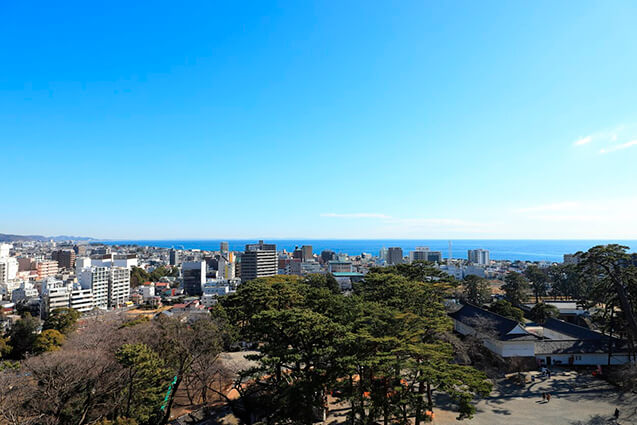
Odawara castle had been regarded as an unassailable fortress that forced back attacks by neighboring feudal lords for a century until Toyotomi Hideyoshi (the lord who brought an end to the Age of Warring States) intruded with a great army in 1590, which was said to be 210,000 soldiers. Castles in general are the symbols of the power and wealth of their lords. But Odawara castle is rather regarded as the symbol of the happiness and prosperity of the people.According to the local historical text Hojoki, just like Kyoto the town of Odawara flourished during the era of Hojo (one of the major feudal lords in Kanto region) realized by the five lords of the blood line. This prosperity was the result of the Hojo’s policy that valued the common wealth.
However, Odawara castle, even though it was not attacked by warriors through the peaceful Edo period, was besieged and damaged by terrible earthquakes, several fires and eruption of Mt. Fuji. It was restored and rebuilt every time. When the era of Tokugawa Shogunate ended in 1868, so did Odawara castle. It was demolished and sold as the new Meiji government aimed to erase symbols of the “old” Japan. Only the stone walls remained, which were later destroyed by a terrible earthquake in 1923. After a century of absence, however, it was revived by a project that sought to rebuild the castle with reinforced concrete. The design was derived from models and drawings of the original at the beginning of the 18th century and completed in 1960. The last restoration, including an anti-earthquake reinforcement, was completed in 2018. The new castle is like a five-floor museum of the local history.
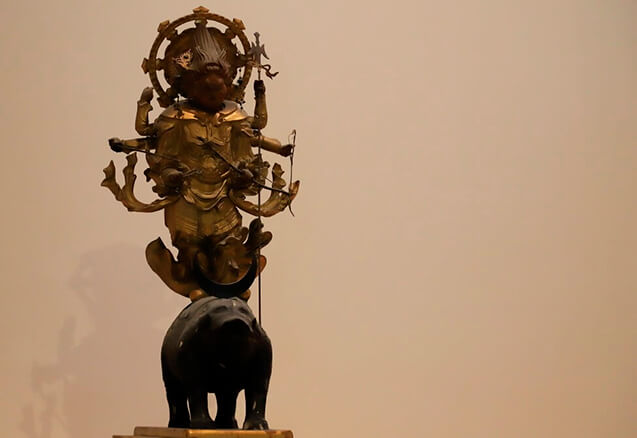
The first floor covers Odawara during the Edo period (1603-1868) when it was under the control of Tokugawa Shogunate and the second floor the period of Warring States (1467-1590); the third and fourth floor is for periodical themed exhibitions, and the fifth floor is for the observatory. Most of the information is in Japanese, but if you download the museum’s multilingual application on your smart phone, it will help you understand the whole history of Odawara in your language.
On the fifth floor, you will find a statue of Marishiten (Marici in Sanskrit) riding on a wild boar. The word “Marici” in Sanskrit originally meant “heat haze” which refers to the minor mirage effect experienced when looking through hot air. The mirage can never be caught, burned, wet or harmed. The god of the mirage is believed to be the invisible protector of the god of the sun. Admiring these qualities, many samurais had a firm faith on Marishiten. This statue was placed in the castle as a protective god of the castle and the town during the Edo period, but it was later removed when the castle was demolished. Now Marishiten is back in a reproduction of its room.
If you look toward the south-west from the top of the castle, you will see on mountains, the original site where Toyotomi Hideyoshi’s castle once stood. That castle was called Ichiyajo (one-night castle) because it was made stealthily to show off the power of Toyotomi and completed before any of Hojo family and his men realized, which made the last Hojo lord surrender.
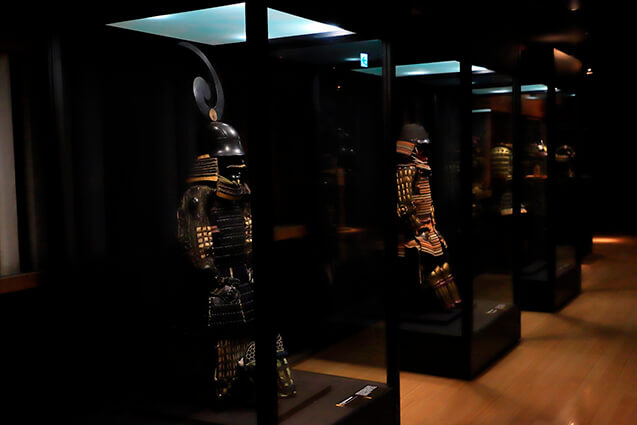
The main gates leading to the castles were also renewed. In Samuraikan (Samurai Gallery) on the second floor at Tokiwagi-mon (the gate Tokiwagi) you can see a collection of beautiful armor and swords. The projection mapping titled “Hana utsu yoroi” (The armor that beats flower) is also enjoyable. Through beautiful images and music, you will be able to be absorbed in the samurai spirit.
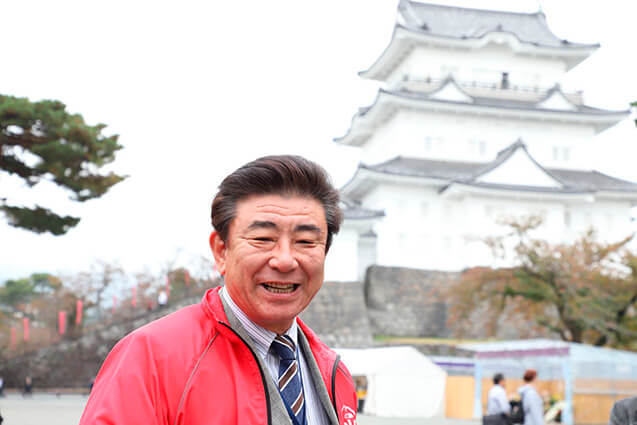
Dr. Jun Suwawa, Ph.D, Senior Curator of Odawara Castle Museum
Odawara castle is also famous for its various kinds of beautiful seasonal flowers; plum blossoms in February, cherry blossoms from the end of March to early April, azalea and wisteria from the mid April to the mid May, iris and hydrangea in June, and lotus flowers in summer. The gorgeous autumn leaves should not be omitted from this list.
Odawara Castle
https://odawaracastle.com/
6-1 Jonai, Odawara-shi, Kanagawa Prefecture
☎ 0465-22-3818
Opening Hours: 9:00 a.m. to 5:00 p.m.
(Entry is allowed up until thirty minutes before the closing time).
10 minutes on foot from the east exit of Odawara Station
Hotoku Ninomiya Shrine
A Sanctuary After 400 Years
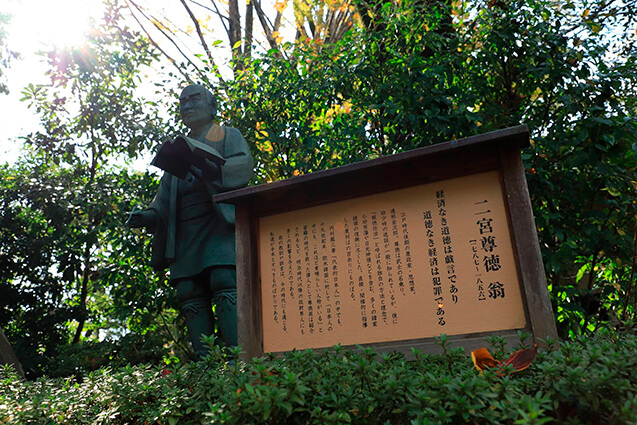
The famous wise words of Sontoku Ninomiya (1787-1856), an agronomist, philosopher and economist are written on the signboard standing beside him; “Moral virtues without economics is nonsense, economics without moral virtues is a crime.”
Sontoku Ninomiya (also called Kinjiro Ninomiya) was born as the first son of a farmer in Odawara and went through hardship during his youth. He also helped the people of Odawara during times of famine by proposing to open up the public granaries to feed those who were starving. He was also a philosopher and was not interested in his own benefit. His Hotoku (moral requital) thinking is as follows: “If you contribute to society instead of exploiting others to satisfy your own needs, the profit will be returned eventually”. After his passing, he was deificated for his great achievement.
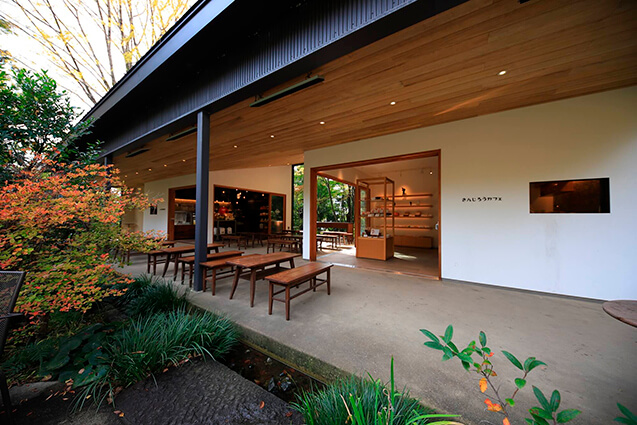
Passing through the second torii gate, you will find two open-air cafés, Café Odawara Kankitsu Club and Kinjiro Café. Having a Caffè latte seated outside amongst trees and singing birds, you may forget that you are at the site of a holy shrine.
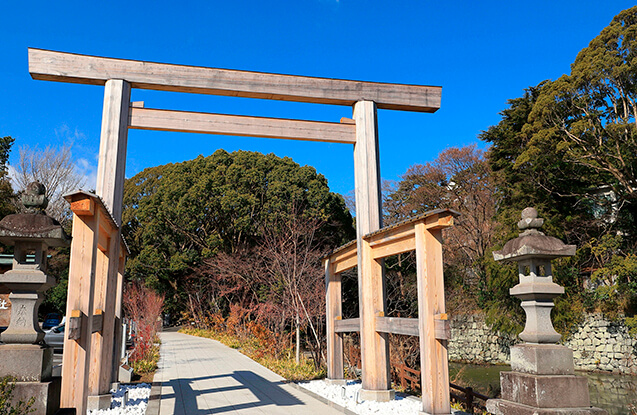
The first torii gate shows off its beautiful natural wood. It is brand new, constructed in 2017 from a 300-year-old cedar tree grown in the forests of Odawara.
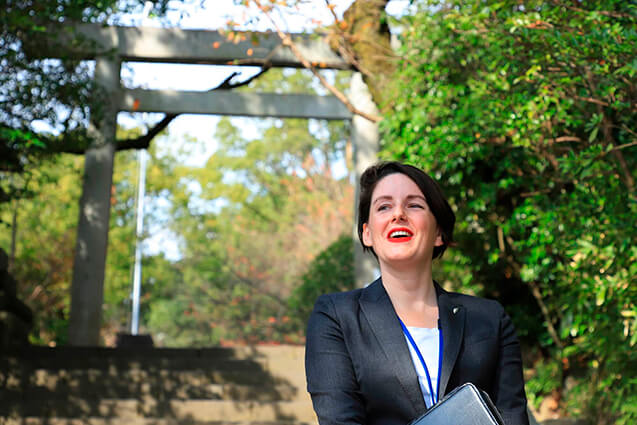
Mrs. Judith Sasaki, Project Manager of “Local Japan” at the Hotoku Ninomiya Shrine. She is fluent in Japanese, English and German, and has a profound knowledge about Shintoism and Japanese culture. By joining her “Discover Shintoism” tour (2 hours) you can learn all about shintoism and its rules. This expert insight is ideal as shintoism is very difficult to understand even for Japanese people. The tour also offers you an occasion where you can write your own ema (Shinto tablet).
Hotoku Ninomiya Jinja (Hotoku Ninomiya Shrine)
http://www.ninomiya.or.jp/
(Inside Odawara Castle Park) 8-10 Jonai, Odawara-shi, Kanagawa Prefecture
☎ 0465-22-2250
Operation Hours: 9:00 a.m. to 5:00 p.m. (office)
Gate’s Closing Time: 6:00 p.m. (5:00 p.m. in winter)
15 minutes on foot from the East Exit of Odawara Station
Seikantei
The Second House of a Politician of the 19th Century
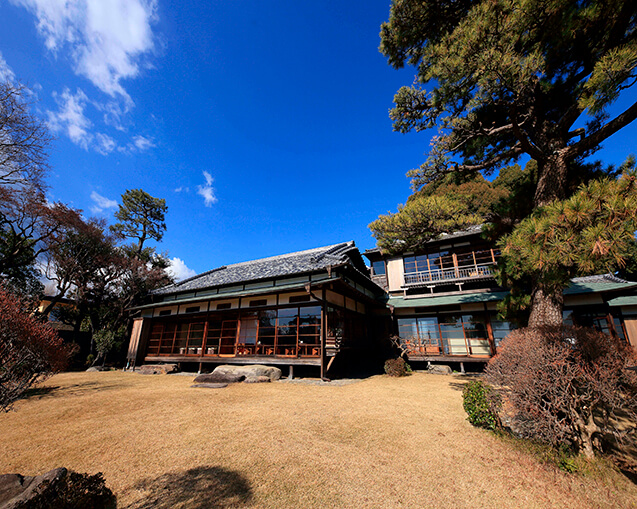
In the latter half of the 19th century, Odawara started to attract celebrities as a resort as it is warm in winter and cool in summer with a great ocean view and delicious seafood. The Imperial villa was built in Ninomaru (the outer citadel) of Odawara Castle. Many politicians of the new government including the first prime minister, business leaders and novelists made their second home in this area. Seikantei, is one of the houses now open to the public and is only a five-minute walk from Hotoku Ninomiya Shrine. It is the second house of the politician, Marquis Nagashige Kuroda, a descendent of a well-known strategist for Toyotomi Hideyoshi, who was the only samurai who was able to make the Lord of Odawara Castle surrender.
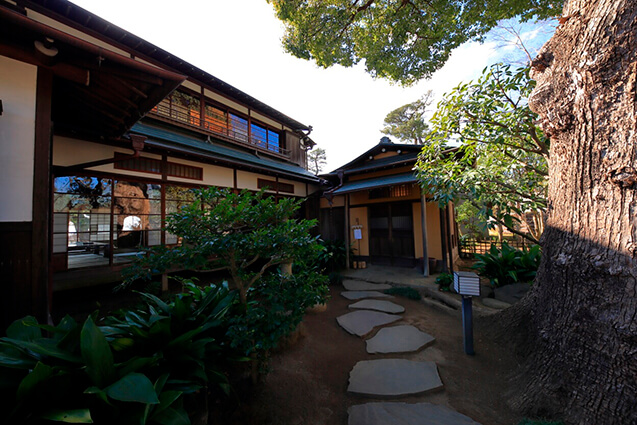
Seikantei, registered as a National Tangible Cultural Property, is made in the traditional method called Shoin-zukuri (Shoin style) with a hint of Sukiya-zukuri (Sukiya style). The word “shoin” means a living room which serves also as a study. Many samurais built their house in this style. On the other hand, “sukiya” is a flexible style, tailored to personal tastes and was loved by tea masters who were interested in diverting from convention and disliked luxurious decorations. This modest but unconventionally decorated house would have been an ideal place for politicians of the new government to relax.
The ocean view from the second floor of Seikantei is beautiful. You can see islands and a peninsula when the day is clear. A cup of tea in a simple traditional house is a wonderful way to relax. Savor its silence and beauty just like a politician of difficult age did.
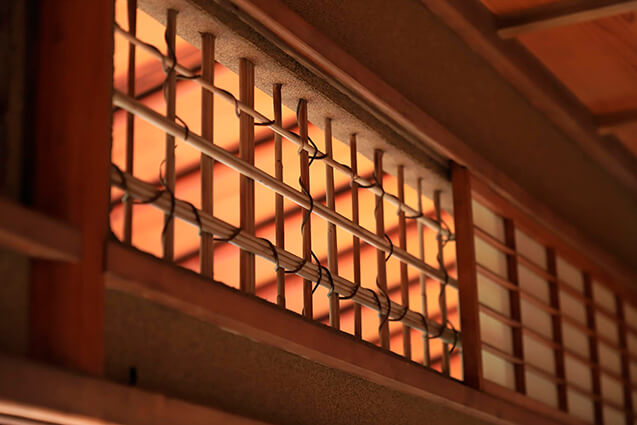
Seikantei seems simple but it was made of about 300,000 trees and its decorations were realized through the meticulous and skillful techniques of artisans. Its simplicity is made with luxurious materials, a Japanese aesthetic ideal.
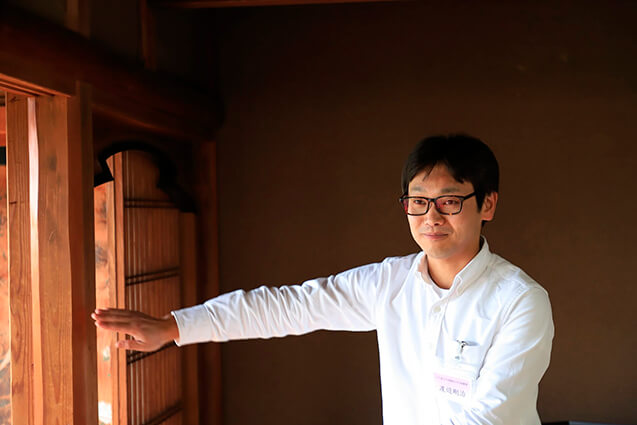
Mr. Watanabe, a member of a non-profit organization that aims to make Odawara a better and more enjoyable place. A guided tour of the house is also in operation. There is also a tour visiting other villas on foot in Odawara.
Seikantei
http://www.city.odawara.kanagawa.jp/public-i/facilities/seikanntei/top-2012.html
1-5-73 Minami-cho, Odawara-shi, Kanagawa Prefecture
☎ 0465-22-2834
Opening Hours: 11:00 a.m. to 4:00 p.m.
Closing Day: Tuesday
15 minutes on foot from Odawara Station
* No car parking space
Daruma Restaurant
Savor the Prosperity of Odawara with your Tongue and Eyes
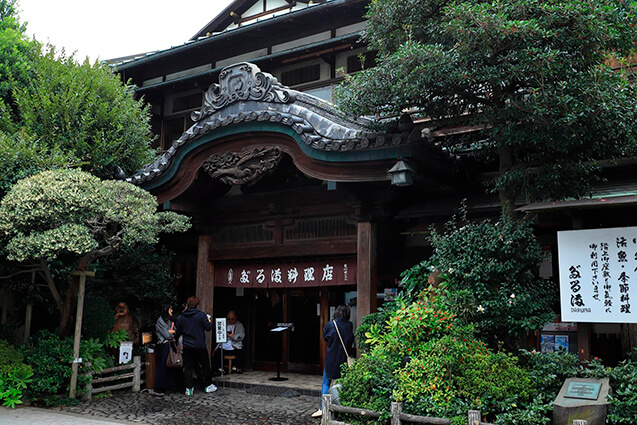
A ten-minute walk from Odawara Castle Park, crossing Manabibashi bridge towards the north-east takes you to a traditionally built wooden house which seems like a shrine or a temple. This is a Japanese restaurant called Daruma Ryoriten (Daruma Restaurant) founded in 1893. The original building was damaged by a terrible earthquake in 1923 but was rebuilt soon afterwards by the second generation of the owner family using abundant national first-class quality material and first-class carpenters.
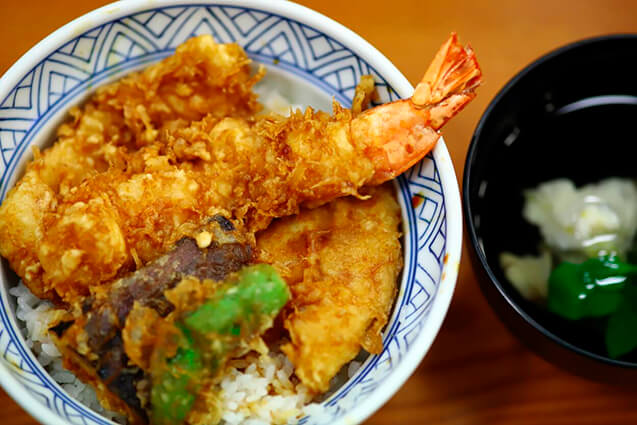
The specialty of Daruma Ryoriten is tempura and thick sushi rolls made from fresh fish. Daruma’s tempura has a golden yellow color that is derived from the sesame oil and high temperature in which it is fried, which is a characteristic feature of Edo style tempura.
Odawara is an oceanside town. At Daruma Ryouriten you can savor fresh seafood in a magnificent room also in debt to the generosity of the ocean. As its dishes have not been changed through its history, you can also savor the past with your tongue.
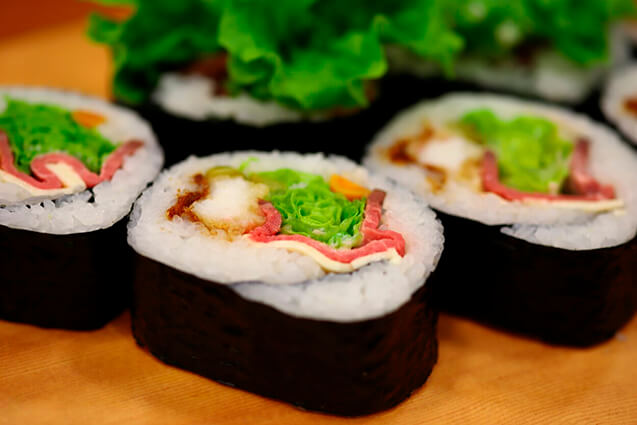
Surprisingly thick sushi rolls made from freshly caught fish called Kaisen-maki inviting you to enjoy it large mouthfuls. There is also another kind thick roll called Daruma-maki, which has a well harmonized taste of Western ingredients; roasted beef combined with cheese and red leaf lettuce, and Japanese ones; shrimp tempura, diced tuna cooked in soy sauce and pokeweed roots.
Daruma Restaurant
http://darumanet.com/
2-1-30 Honcho, Odawara-shi, Kanagawa Prefecture
☎ 0465-22-4128
Opening Hours: 11:00 a.m. to 9:00 (The last call is one hour before the closing time.)
Closing Day: The first three days of the New Year
10 minutes on foot from Odawara Station or from Odawara Castle Park
Odawara Town Strolling
A Walk to Experience the Past
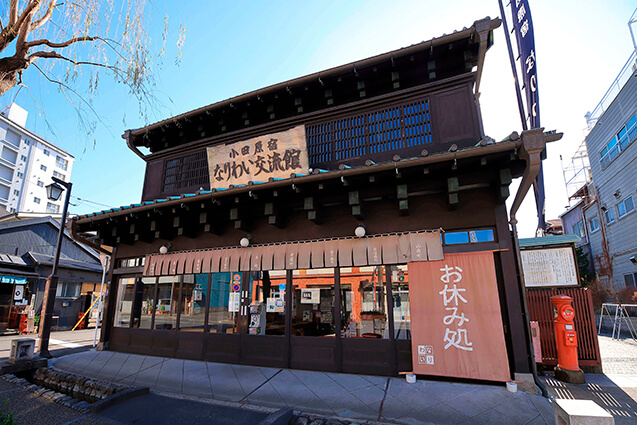
Odawarajuku Nariwai Koryukan, which is like a visitors’ center or resting place, opened in 2001. It is in a refurbished old wholesaler of fish nets, built in 1932, and is an excellent example of the typical style of shops in Odawara. The first floor has a lounge with tatami mats which any one can use free of charge. The second floor is for events. A mini course in foldable lantern making is available (reservation required).
Strolling around town is one pleasing way to appreciate Odawara. Thanks for the Hojo administration’s commitment to advancing the local culture, Odawara is a birthplace of traditional crafts such as marquetry called yosegi-zaiku (which is a type of wood mosaic), foldable paper lanterns, lacquerware and metal casting. The specialty food stores are also interesting to explore. Kamaboko (which is a type of fish cake or surimi), dried fish, umeboshi (fermented plums) and pickles are just some of the foodstuff local to the area. Some of the shops and factories for these local products, which are scattered throughout town, also serve as small museums where visitors can deepen their interest and knowledge of Odawara and its long history. You can obtain information necessary for your visit at the Tourist Information Center in Odawara Station and at Odawara Odawarajuku Nariwai Koryukan. Various kinds of guided tours are also available.
Mainly on weekends and holidays, Odawarajuku Circular Tourist Bus, Umemaru-go that goes around Odawara and stops at major tourist attractions operates.
http://kanko-kaiyu-bus.org/schedule.html
Odawarajuku Nariwai Koryukan
http://www.nariwai-kouryukan.org/
3-6-23 Honcho, Odawara-shi, Kanagawa Prefecture
☎ 0465-20-0515
Opening Hours: 10:00 a.m. to 7:00 p.m.
(Seasonal variation: from November to March it closes at 6:00 p.m.)
Closing Day: December 31
15 minutes on foot from the East Exit of Odawara Station
Uiro Museum
Witnesses the History of Odawara: the Medicinal and the Sweet

Less than ten minutes away from Odawara Castle on foot, you will find a little castle-like building on the main street of Odawara, the National Route 1. Its door opens to the fascinating world of Japanese candy called uiro. First, you will be amazed at the beautifully decorated show case with various types of uiro and other kinds of Japanese traditional confectionary. All the colors used are not vivid but soft and elegant. The beauty of the packaging will also attract your eyes. Secondly, you will be surprised at the corner where medicine is sold by staff members wearing white robe. There is a historical warehouse beside the shop, built in 1885. It is now used as a museum that tells the over 600 year history of Uiro’s family. As it was not damaged at the time of a terrible earthquake in 1923, you can feel the flow of 130 years by seeing the displayed items, perceiving the scent and touching the wooden pillars. Here in this museum, you will be able to feel the Japanese virtue of cherishing old things and tradition.
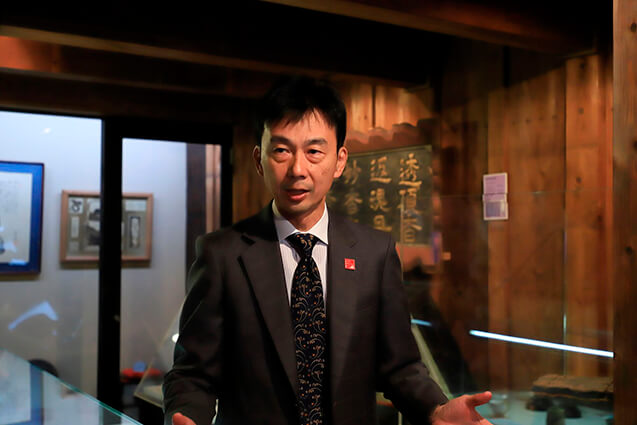
Mr. Toemon Uiro, the 25th generation of the Uiro family
You can enter Uiro Museum without charge if you ask the staff. If you are lucky, you can see Mr. Uiro and listen to the history directly from him.
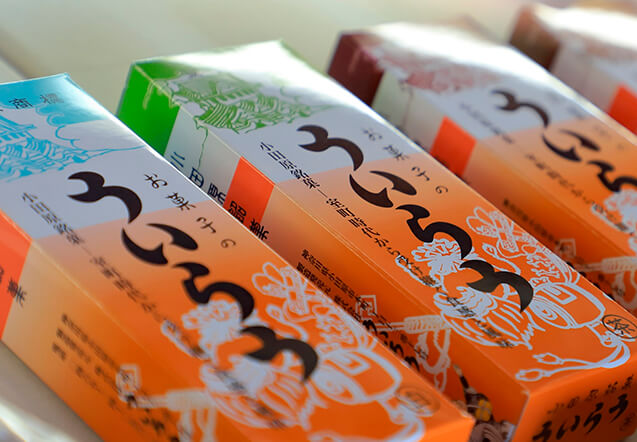
Uiro is a type of candy made from powdered rice and sugar. Its distinctive feature is its bar-like shape, and it is sliced thick to be served. If you know much about Japanese candy, you may imagine yokan. Uiro is less sweet and softer than yokan and it has a pleasantly chewy texture. According to Mr. Toemon Uiro, the ancestor of the Uiro family, who worked as a diplomatic officer at Imperial Court, made original sweets for foreign visitors using sugar which he imported, and this is the origin of the Uiro family’s confectionary.
Uiro Museum
http://www.uirou.co.jp/museum.html
1-13-17, Honcho, Odawara-shi, Kanagawa Prefecture
☎ 0465-24-0560
Opening Hours: 10:00 a.m. to 5:00 p.m.
Closing Day: Wednesday and the third Thursday
15 minutes on foot from Odawara Station
*Guided tour of the museum is free of charge.
Kamaboko Street
Local Delicacies with Over 200 Years of History

Walking through the town towards the ocean, you will arrive at a district with roots stretching back hundreds of years. Now the district is called Kamaboko Street, named after the 13 shops which sell kamaboko (fish cake) there. There are also interesting and unique shops that sell hard dried bonito called katsuobushi and semi-dried fish called hiraki, which are the Japanese traditional delicacies essential for Japanese daily diet. There are also traditional confectionary shops for those with a sweet tooth.
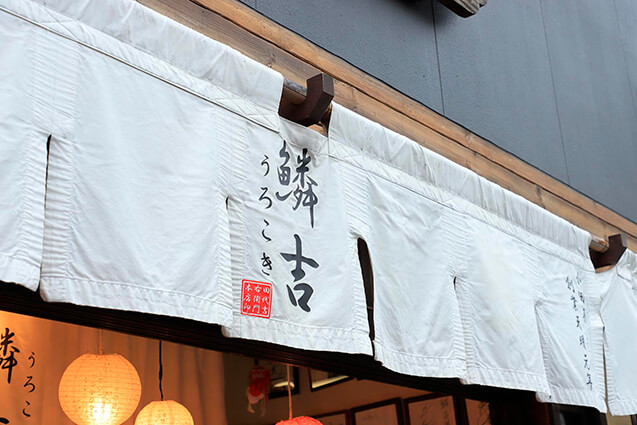
Urokoki is one of the kamaboko shops situated behind Odawarajuku Nariwai Koryukan in the middle of the Kamaboko Street. Urokoki was established in 1781, and is the oldest kamaboko shop in Odawara. Urokoki maintains the high standards of its ancestors; fish meat is still ground by stone mills and silver croaker, which is known as high-quality fish, is used as the traditional key ingredient. Surprisingly Mr. Tashiro is particular about the cut of each kamaboko piece; a thickness of 15mm ensures superb taste and the texture. Kamaboko is known overseas and some of you may have tasted surimi. You will be surprised at the big difference between Urokoki’s kamaboko and the surimi you are familiar with!
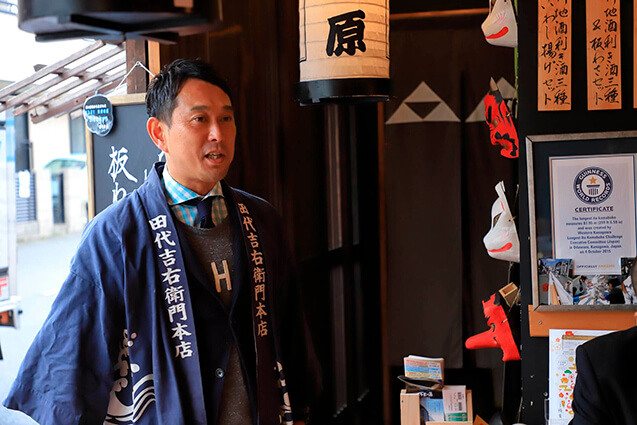
Mr. Moritaka Tashiro, the eighth generation of the owner family of Urokoki,
Urokoki also has a space where you can be seated at a table-like hearth and taste Urokoki’s kamaboko and oden with local sake.
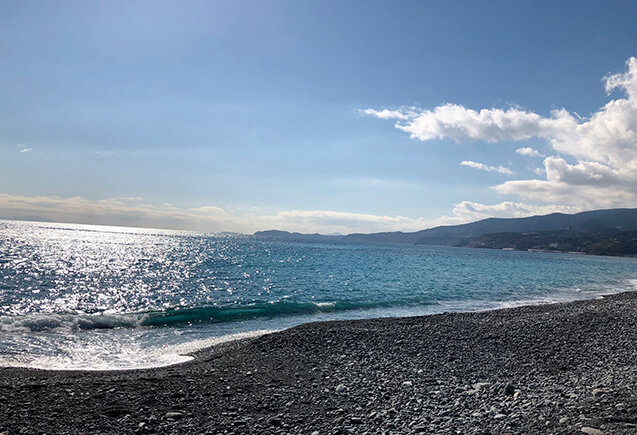
A small path, passing under the tunnel (the bypass highway that connects Odawara and Oiso runs over the tunnel) takes you to a sandy beach. Here great many fishing boats departed and returned. Boats that had a big haul displayed a colorful flag, which is a traditional custom among fishermen in Japan. The Meiji emperor and princess visited this beach to see fishermen at work drawing the beach seine.
Kamaboko Street
https://www.odawarakamabokodori.com/
Urokoki
http://www.urokoki-kamaboko.com/
3-7-17 Honcho, Odawara-shi, Kanagawa Prefecture
☎ 0465-22-1315
Opening Hours: 9:00 a.m. to 5:00 p.m.
Closing Day: the third Thursday
15 minutes on foot from the East Exit of Odawara Station
vol.11 Part1 Odawara Area in Kanagawa Prefecture
Listen to the Lingering Sounds of History
Tourist Attractions Within 15 Minutes on Foot from Odawara Castle 〈Part1〉
(Odawara Area in Kanagawa Prefecture Booklet PDF)
(Odawara Area in Kanagawa Prefecture Booklet PDF [for printing])
This project is supported by the Kanto Bureau of Economy, Trade and Industry.
- 1
- 2









